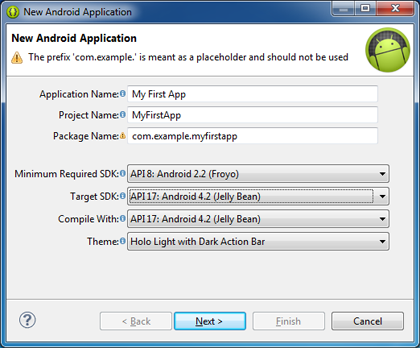This lesson teaches you to
You should also read
An Android project contains all the files that comprise the source code for your Android app. The Android SDK tools make it easy to start a new Android project with a set of default project directories and files.
This lesson shows how to create a new project either using Eclipse (with the ADT plugin) or using the SDK tools from a command line.
Note: You should already have the Android SDK installed, and if you're using Eclipse, you should also have the ADT plugin installed (version 21.0.0 or higher). If you don't have these, follow the guide to Installing the Android SDK before you start this lesson.
Create a Project with Eclipse
- Click New
 in the toolbar.
in the toolbar. - In the window that appears, open the Android folder, select Android Application Project, and click Next.
- Fill in the form that appears:
- Application Name is the app name that appears to users. For this project, use "My First App."
- Project Name is the name of your project directory and the name visible in Eclipse.
- Package Name is the package namespace for your app (following the same rules as packages in the Java programming language). Your package name must be unique across all packages installed on the Android system. For this reason, it's generally best if you use a name that begins with the reverse domain name of your organization or publisher entity. For this project, you can use something like "com.example.myfirstapp." However, you cannot publish your app on Google Play using the "com.example" namespace.
- Minimum Required SDK is the lowest version of Android that your app supports, indicated using the API level. To support as many devices as possible, you should set this to the lowest version available that allows your app to provide its core feature set. If any feature of your app is possible only on newer versions of Android and it's not critical to the app's core feature set, you can enable the feature only when running on the versions that support it (as discussed in Supporting Different Platform Versions). Leave this set to the default value for this project.
- Target SDK indicates the highest version of Android (also using the
API level) with which you
have tested with your application.
As new versions of Android become available, you should test your app on the new version and update this value to match the latest API level in order to take advantage of new platform features.
- Compile With is the platform version against which you will compile your app. By default, this is set to the latest version of Android available in your SDK. (It should be Android 4.1 or greater; if you don't have such a version available, you must install one using the SDK Manager). You can still build your app to support older versions, but setting the build target to the latest version allows you to enable new features and optimize your app for a great user experience on the latest devices.
- Theme specifies the Android UI style to apply for your app. You can leave this alone.
Click Next.
- On the next screen to configure the project, leave the default selections and click Next.
- The next screen can help you create a launcher icon for your app.
You can customize an icon in several ways and the tool generates an icon for all screen densities. Before you publish your app, you should be sure your icon meets the specifications defined in the Iconography design guide.
Click Next.
- Now you can select an activity template from which to begin building your app.
For this project, select BlankActivity and click Next.
- Leave all the details for the activity in their default state and click Finish.

Figure 1. The New Android App Project wizard in Eclipse.
Your Android project is now set up with some default files and you’re ready to begin building the app. Continue to the next lesson.
Create a Project with Command Line Tools
If you're not using the Eclipse IDE with the ADT plugin, you can instead create your project using the SDK tools from a command line:
- Change directories into the Android SDK’s
tools/path. - Execute:
android list targets
This prints a list of the available Android platforms that you’ve downloaded for your SDK. Find the platform against which you want to compile your app. Make a note of the target id. We recommend that you select the highest version possible. You can still build your app to support older versions, but setting the build target to the latest version allows you to optimize your app for the latest devices.
If you don't see any targets listed, you need to install some using the Android SDK Manager tool. See Adding Platforms and Packages.
- Execute:
android create project --target <target-id> --name MyFirstApp \ --path <path-to-workspace>/MyFirstApp --activity MainActivity \ --package com.example.myfirstapp
Replace
<target-id>with an id from the list of targets (from the previous step) and replace<path-to-workspace>with the location in which you want to save your Android projects.
Your Android project is now set up with several default configurations and you’re ready to begin building the app. Continue to the next lesson.
Tip: Add the platform-tools/ as well as the
tools/ directory to your PATH environment variable.